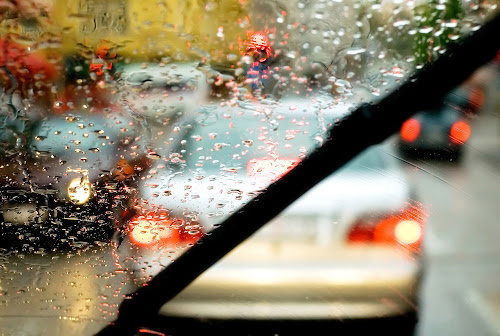Weather changes and precipitation always present an array of challenges for drivers, and rain (especially a heavy downpour) can make for an especially difficult driving experience. While accident rates can be higher when it comes to rainy conditions, there are many ways to promote driver safety during tumultuous weather. It all comes down to understanding how rain affects the road and acknowledging that reduced visibility will have adverse effects on driving ability.
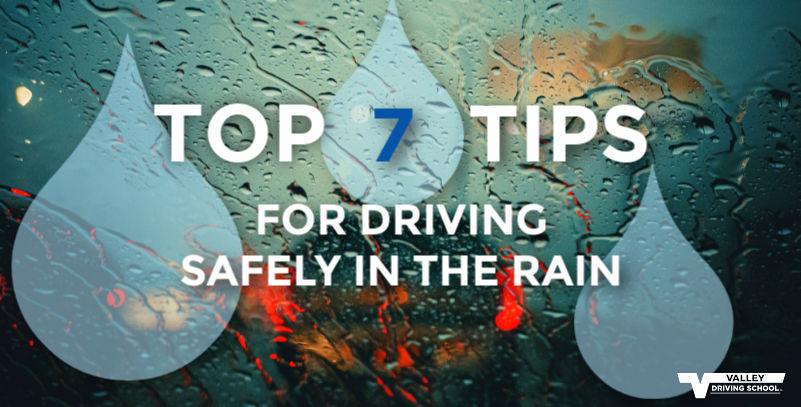
Read below for 7 of our rainy-weather tips that will help you continue to be a safe and confident driver!
#1 Pre-trip Check Your Vehicle
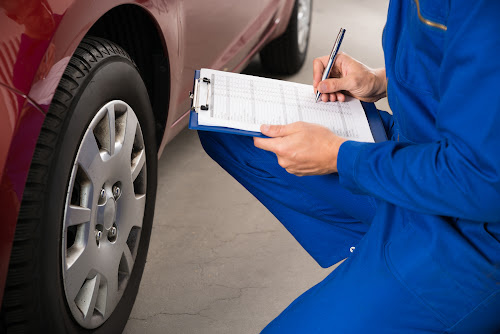 If the forecast calls for rain, do a quick check of your car’s equipment and functions before getting on the road. This includes headlights, tail lights, windshield wipers and tire pressure. Your headlights and tail lights should be working and not dim, and the plastic casing around them should be clean and not foggy. The windshield wipers should be securely attached to the wiper arms or your vehicle, and the blades should be smooth and intact, with no missing pieces of rubber. Having adequate tire pressure will help your vehicle maintain traction and grip while driving so it’s important to check them, and fill if necessary. In the event of any weather-related emergency, it's important to know that you can depend on your vehicle.
If the forecast calls for rain, do a quick check of your car’s equipment and functions before getting on the road. This includes headlights, tail lights, windshield wipers and tire pressure. Your headlights and tail lights should be working and not dim, and the plastic casing around them should be clean and not foggy. The windshield wipers should be securely attached to the wiper arms or your vehicle, and the blades should be smooth and intact, with no missing pieces of rubber. Having adequate tire pressure will help your vehicle maintain traction and grip while driving so it’s important to check them, and fill if necessary. In the event of any weather-related emergency, it's important to know that you can depend on your vehicle.
#2 Adjust Your Speed
Your vehicle’s reaction time can be much slower than usual when it’s raining, and the roads can be more dangerous. The posted speed limit on any road is intended for ideal driving conditions and when the conditions deteriorate, a slower speed is safer. There is no shame in slowing down and, in fact, it’s the safe thing to do!
#3 Increase Your Following Distance
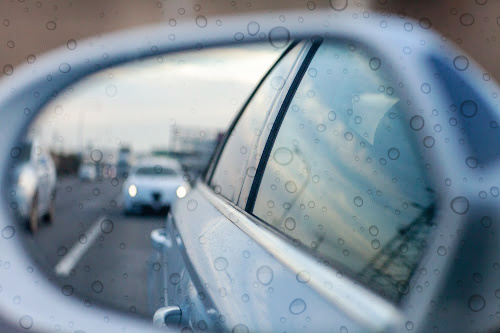 Braking becomes more difficult in the rain! Wet roads lead to there being less friction between your vehicle and the road, which can lead to less responsive braking, so to combat this, you should have an increased following distance while driving on wet roads. The following distance in ideal conditions is 2-3 seconds, and you should increase this to 4-5 seconds while driving on wet roads - this will give you more time to apply your brakes and slow down. Stay in control of your vehicle and refrain from using cruise control so you are able to concentrate on the accelerator, brakes and the other drivers’ behaviour.
Braking becomes more difficult in the rain! Wet roads lead to there being less friction between your vehicle and the road, which can lead to less responsive braking, so to combat this, you should have an increased following distance while driving on wet roads. The following distance in ideal conditions is 2-3 seconds, and you should increase this to 4-5 seconds while driving on wet roads - this will give you more time to apply your brakes and slow down. Stay in control of your vehicle and refrain from using cruise control so you are able to concentrate on the accelerator, brakes and the other drivers’ behaviour.
#4 Be Seen By Others
Increasing your visibility to others means ensuring your headlights and tail lights are ON. You may be practicing safe driving techniques, but that doesn’t mean the other vehicles on the road are. Protect yourself by making yourself seen. If your vehicle has automatic lights, just because it’s raining doesn’t necessarily mean that it is dark enough for your vehicle to turn your lights on for you. Many vehicles, whether they have automatic lights or not, will often have daytime running lights on. While these may create enough light for you to see in front of you, daytime running lights don’t often include the taillights - which means vehicles behind you may not be able to see you until they are too close. If you’re unsure where your interior controls need to be in order for your headlights and taillights to be on, you should spend some time either reading through your owner’s manual or trying out different settings while you’re parked, before you leave. This way, you can change a setting and then hop out to see what lights have illuminated.
#5 Use Your Wipers
It’s easy to forget even the most obvious tasks when focusing on the wet roads ahead, and depending on your vehicle’s settings, the windshield wiper blades may need some adjusting when it starts raining. If you have multiple speed settings, or have auto-detecting wipers, make sure you pick the best setting for how much rain is falling and how quickly it is accumulating on your windshield. If your wipers are not adequately clearing your windshield, pull over in a safe location, put on your hazards, and proceed when the rain has subsided. If your wipers can’t keep up, this is putting you in a high risk situation that can be avoided by waiting the rain out.
You will also want to keep your windshield as clean as possible before heading out on your drive - wipe away any dirt, smudge marks, or insect leftovers. Keeping your windshield clean while you’re driving is important too! Make sure that you have adequate windshield washer fluid before you head out, because even though you might clean your window ahead of time, other vehicles or changing weather conditions can mean more dirt or dirty water making its way onto your windshield.
#6 Be Prepared for Hydroplaning
Be aware that hydroplaning may occur! When driving through standing water, you may lose control and traction, causing your vehicle to skid and slide across the wet road. Try to avoid heavily rained-on areas of the road by lane switching and staying aware. If hydroplaning is inevitable, calmly and slowly release your foot from the gas pedal and steer your vehicle in your desired direction. Do not panic, do not act with haste. You can recover from hydroplaning by keeping your cool, but sudden movements will put you at risk if you’ve already lost control of your vehicle.
#7 Use Your Defroster
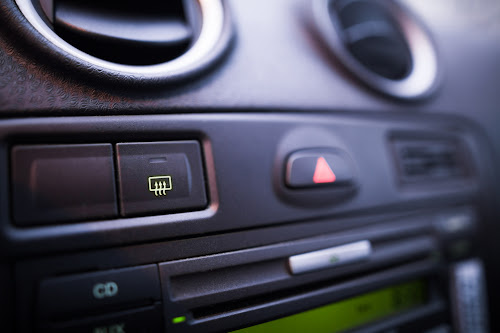 Ventilate your vehicle! If your car has a defroster, which prevents the windows from fogging internally, make sure you use it. Most cars will have a front window defrost, and some will have a rear window defrost. These are usually controlled with two different buttons, but they are both often found on the middle dashboard console. The front defroster works with your heating and cooling fans to blow air onto the front windshield, clearing any fog or condensation that has accumulated. The rear defroster uses thin lines or grids of wires inside the rear window that heats the surface to clear away condensation, snow, and helps to melt ice! If the condensation on your windows and windshield decreases your visibility drastically, it may be best to pull over and allow for the fog to subside until it is safe to drive again.
Ventilate your vehicle! If your car has a defroster, which prevents the windows from fogging internally, make sure you use it. Most cars will have a front window defrost, and some will have a rear window defrost. These are usually controlled with two different buttons, but they are both often found on the middle dashboard console. The front defroster works with your heating and cooling fans to blow air onto the front windshield, clearing any fog or condensation that has accumulated. The rear defroster uses thin lines or grids of wires inside the rear window that heats the surface to clear away condensation, snow, and helps to melt ice! If the condensation on your windows and windshield decreases your visibility drastically, it may be best to pull over and allow for the fog to subside until it is safe to drive again.
--
Driving in the rain doesn’t have to be overwhelming or frightening, as long as you have the know-how and confidence to take your time, stay aware, and know what to do in an emergency. And don’t forget - there’s always sunshine after the rain!

